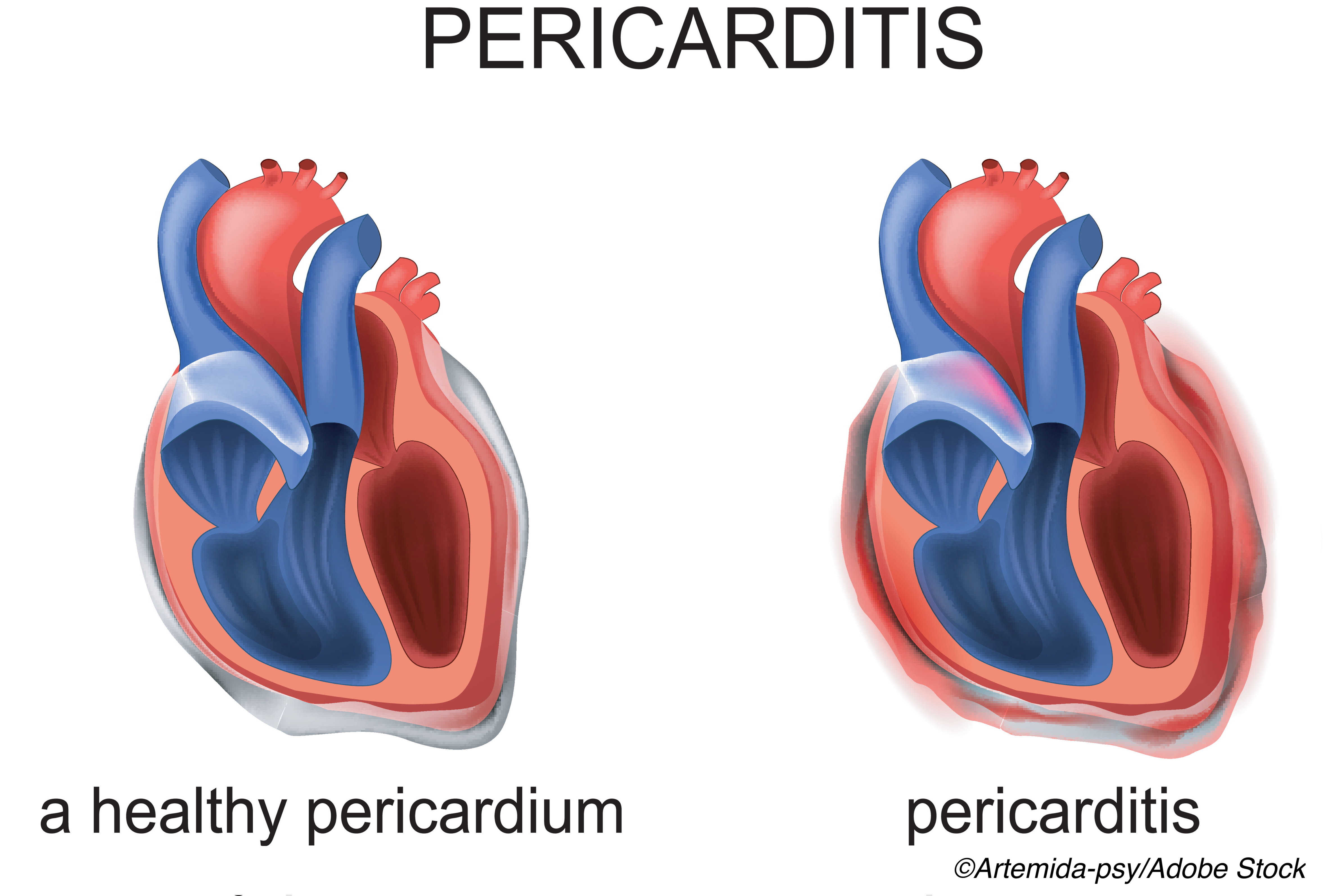Patients hospitalized with pericarditis showed higher rates of mortality, co-morbidity, and hospital readmission over five years than matched controls, a Danish registry study showed.
“In a nationwide cohort of patients with apparent incident viral or idiopathic pericarditis admitted to the hospital, we observed an increased mortality risk within the five-year follow-up compared to a matched sample of the general population,” said Flora Sigvardt, MB, of Copenhagen University Hospital, and co-authors in the Journal of the American College of Cardiology. “This risk was particularly present in female patients.”
“Our results support the hypothesis of viral or idiopathic pericarditis as an early sign of other severe conditions and warrant focus on early diagnostic approaches,” they noted.
The researchers identified 7,988 patients with first-time viral or idiopathic pericarditis between 1996 and 2016 in Danish national registries excluding those with a severe underlying heart condition or pericardial effusion and compared them with 79,880 age- and sex-matched controls.
Absolute five-year survival probability was 92.9% and 95.8% in the pericarditis and control groups, respectively (adjusted HR 1.31, 95% CI 1.13-1.52). Mortality differences were greatest in the first year and were found for females (adjusted HR 1.6, 95% CI 1.30-2.00; P < 0.001), with no significant difference for males (P = 0.158).
Malignancy-associated death was seen at a higher rate in those with pericarditis (41% versus 32% for pericarditis versus control groups, respectively). Malignancy of the respiratory system was also elevated in the pericarditis group at 1 year (2.8 versus 1.1 per 1,000 person-years; incident rate ratio (IRR) 2.66, 95% CI 2.20-3.30).
At one year, recurrent pericarditis was common (13.1%, or 31.7 events per 1,000 person years). Cardiovascular disorders, including arrhythmias and myocardial infarction were more frequent for pericarditis versus controls (23.7 versus 13.6 per 1,000 person-years, respectively), as was incident arthritis (2.2 versus 0.7 per 1,000 person-years, respectively).
Having a new-onset, admission-requiring diagnosis also was more likely in the pericarditis group, for both cardiovascular and non-cardiovascular diseases.
“These important observations should promote the awareness of both cardiovascular and non-cardiovascular associations in patients presenting with viral/idiopathic pericarditis,” wrote Allan Klein, MD, of the Cleveland Clinic in Ohio, and co-authors in an accompanying editorial.
The study “reaffirms previous observations that idiopathic pericarditis may be an early manifestation of undiagnosed or incipient systemic disease,” Klein and colleagues noted. “Whether ongoing inflammation drives mortality and the role of suppressive, anti-inflammatory therapy in altering these outcomes remains unclear.”
Pericarditis accounts for about 5% of acute chest pain presentation. Outside settings where tuberculosis is an important cause, it is usually presumed to be of viral or idiopathic etiology. “Only when other agents, such as bacteria, cancer, or tuberculosis, are suspected is a biopsy or diagnostic drainage performed,” the editorialists observed.
Treatment includes aspirin, nonsteroidal anti-inflammatory drugs, corticosteroids and colchicine. Although it often resolves, pericarditis may recur (15-30%), become incessant and chronic, or lead to uncommon but serious complications such as tamponade. Pericarditis is also known as a manifestation of underlying systemic disease, and has been linked to inflammatory or autoimmune disorders and malignancy.
“Recurrent pericarditis, pericardial effusion, incomplete recovery after anti-inflammatory treatment, and increased age have potential neoplastic associations,” the editorialists noted.
The cohort Sigvardt and colleagues studied was about 76% men with a mean age of 45. History of malignancy at baseline was present in 2.7% of the pericarditis group and 1.1% of controls. Patients older than the mean age of 45 had increased mortality risk compared with those younger (HR 1.3, 95% CI 1.1-1.5; P<0.00).
A secondary analysis of subsequent autoimmune or inflammatory disease showed elevated risk in the pericarditis group vs controls for both female (IRR 4.0, 95% CI 2.9-5.5) and male (IRR 2.3, 95% CI 1.8-3.0) participants.
Sensitivity analysis excluding all cases and controls with a prior history of malignancy found similar mortality patterns, although less pronounced and with borderline significance, the authors noted. For that analysis, the mortality HR overall all was 1.08 (95% CI 0.9-1.3): for males 0.91 (95% CI 0.7-1.2) and for females 1.31 (95% CI 1.0-1.7).
“Does this mean all patients with acute pericarditis need a comprehensive malignancy and autoimmune screen?” the editorialists asked. “Investigative practices after pericarditis merit a measured and patient-focused approach, but several unanswered questions remain for this common presentation with unmet clinical need.” Knowledge about individual patient-level prognostic associations was limited, and how to conduct surveillance and diagnosis for patients with idiopathic pericarditis was uncertain, they noted.
“These findings highlight the residual adverse risk associated with pericarditis in the current era and the ever-increasing roles of inflammation and immunity connecting cardiac and systemic disease,” they added. “The latter is important as the management of pericarditis moves toward targeted anti-inflammatory therapy with interleukin-1 inhibitors. Translating population data into individualized patient management and surveillance will be the challenge moving forward.”
The phase III RHAPSODY trial of rilonacept, an interleukin-1α and interleukin-1β inhibitor, in recurrent pericarditis is ongoing.
Limitations of the analysis include those inherent to observational studies, including possible unmeasured confounders. Echocardiographic, clinical, and biochemical data were lacking. Despite these limitations, the study results show “informative prognostic and causal associations that warrant prospective validation,” the editorialists noted.
-
Patients hospitalized with pericarditis showed higher rates of mortality, co-morbidity, and hospital readmission over five years than matched controls, a Danish registry cohort study showed.
-
Results support the hypothesis of viral or idiopathic pericarditis as an early sign of other severe conditions and warrant focus on early diagnostic approaches, the researchers suggested.
Paul Smyth, MD, Contributing Writer, BreakingMED™
The researchers had no disclosures.
Klein has received a research grant and served on the Scientific Advisory Board for Kiniksa and has served on the scientific advisory board for Sobi.
Cat ID: 102
Topic ID: 74,102,791,570,730,102,2,913,914,142,192,925




Create Post
Twitter/X Preview
Logout